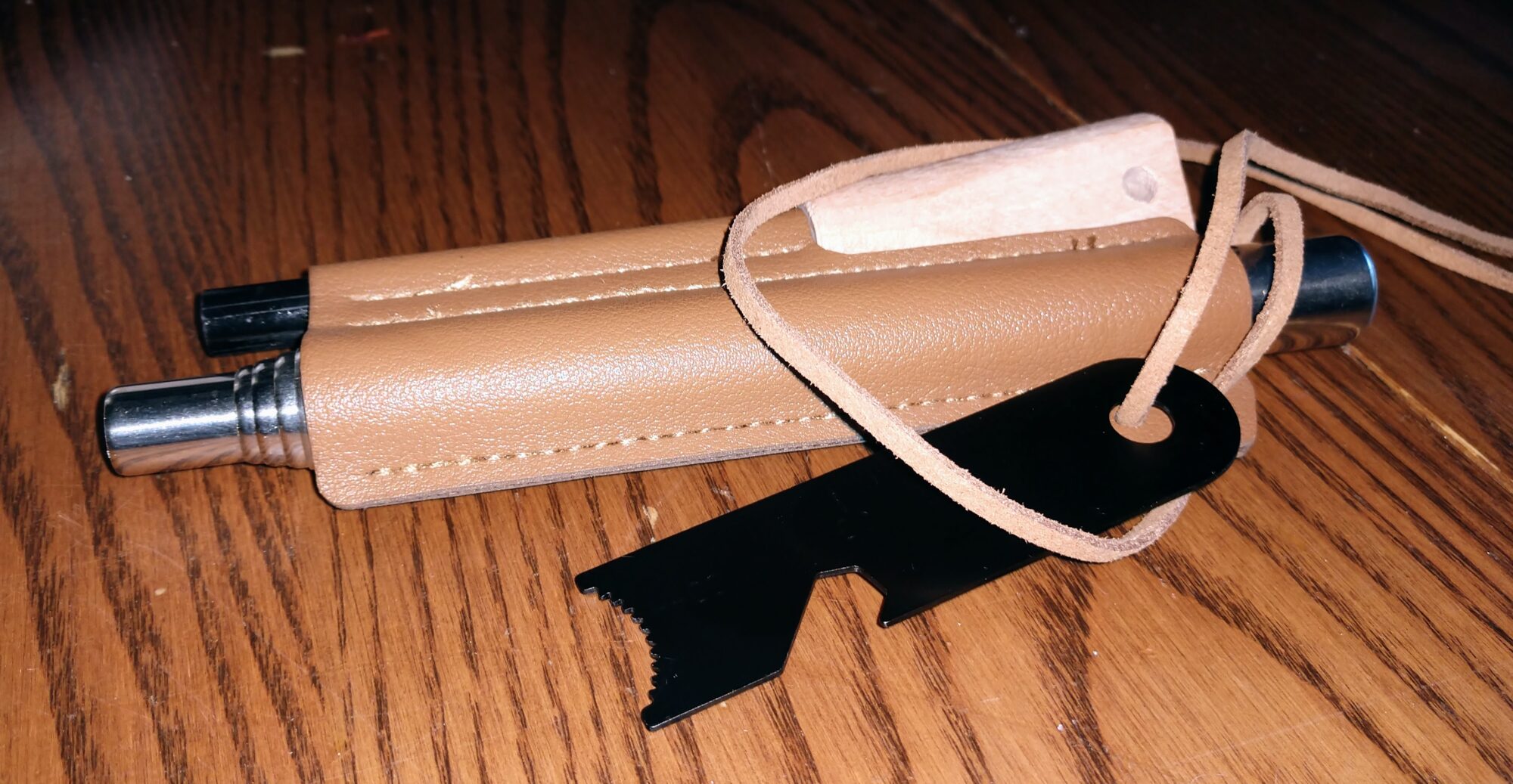
FIRE!
Fire is one of those things that it’s important to know about in emergency situations. You want to know how to get it started, how to keep it going, how to bank it overnight, and how to use it to do various things. You also need to know more than one way to do each of those things.
Making fire is probably the one that stumps most people. There’s this tendency to fall back on “oh, I’ll use a lighter”. I’m guilty of it myself, to a certain extent, and I almost always have a lighter on me somewhere. But lighters run out of fuel, and they get wet, and they can get lost. So what happens then?
Knowing how to make and use char cloth is one path to fire. Having or knowing how to find dry tinder, even in went conditions is another. There’s also flint and steel. But what do you do once you have those ingredients?

This is a picture of the cheap striker I got through an online cheap-ass place called Temu. I think I paid $1.98 for it. It has a ferro rod, a striker, and a blow tube, all in a neat little kit with a neck strap.
Did you know that when most ferro rods arrive, they have a coating on them that you need to work through before you can get a decent spark? Something to know. Something I did NOT know until this afternoon. I learned.
Do you know how to get a spark from flint and steel, or ferro rod and striker? Do you know how to get the spark to be where you want it? It’s not nearly so easy as one might think, and it requires a bit of practice in optimal circumstances before you get into an emergency.
Luckily, it’s not expensive to practice. You can make char cloth out of any old cotton (denim jeans, old tee shirts, kids’ spit up cloths, you name it) or linen. Here’s a good video on making it, with some wonderful side info. And another website with good pics.
Okay, so now you have char cloth. What about tinder? Technically you don’t need both (char cloth IS tinder after all), but knowing how to find or make tinder is as important as knowing how to make char cloth. After all, if you have the means to make char cloth, but no fire, then what do you do? 🙂
Tinder can be anything that’s very small and very flammable. Tinder is smaller than the tiny sticks you use to get a fire built up. It’s fine and light and fluffy. As an example, even in wet climates, if you can find a cedar tree, you can scrape the underside of the bark for a feathery soft stuff that makes great tinder.
Tinder’s job is to catch your spark. That’s it. Now you have a spark, and it’s glowing, and you need to add more fuel to it. Larger pieces of tinder, such as very fine branches from pine trees, can be added. You can make feather sticks (thin, dry sticks that you ‘feather out’ with a sharp knife or axe) to help you make the spark into more. You blow on the ember in the fluff of tinder, and hopefully, the ember becomes smoke, and the smoke becomes fire. Take your tiny fire and add it to the previously laid base of your fire.
There are many ways to build that base, such as log cabin and tipi style. Practice, so you know what works best for you, in which conditions. I tend to use a log cabin style when building fires in dry weather, but I find tipi works better when it’s wet. Awa taught me how to use a military poncho as a cover while building a fire in the rain.
Being able to get your spark to the right spot differs depending on what method you’re using to make a spark. If you’re using a ferro rod, most people’s instinct is to hold the rod over the tinder, then push the scraper down it. Unfortunately, this can cause your spark to go wild. A better way is to hold the scraper in place, and pull the rod up along it. Give both a try, and see what happens. Practice!
When you’re using flint and steel, you want your tinder in your hand, and you spark toward that. And that takes a LOT of practice, and you’ll probably skin your knuckles a number of times in the process of learning. I’ve been doing flint and steel work for about five years, and I’m still terrible at it. I’m passably good with a ferro rod, but I can’t possibly know that I’ll have one on hand, so… I practice with flint and steel.
So, what if you don’t have a ferro rod, or flint and steel, or a lighter? It’s time to use friction. But friction is the least easy method for making fire, even though it can be effective. This is another one that really requires you to go and do it, practice it, and use it on a regular basis in order to perfect it. And all that practice must be done before the emergency, because when you’re in the midst of it, you won’t have time to be putzing around with learning new things.
This site discusses several methods of making fire using friction: bow drill, pump drill, hand drill, and fire plough. And then there’s this great article on Instructables, which adds more to the list: the two man friction drill, and a fire piston, in addition to instructions on the ones at the first site.
So… go add to your skill set! 🙂 Have fun in the process, and impress your friends. Stay warm, stay dry, and learn.
Like this:
Like Loading...







